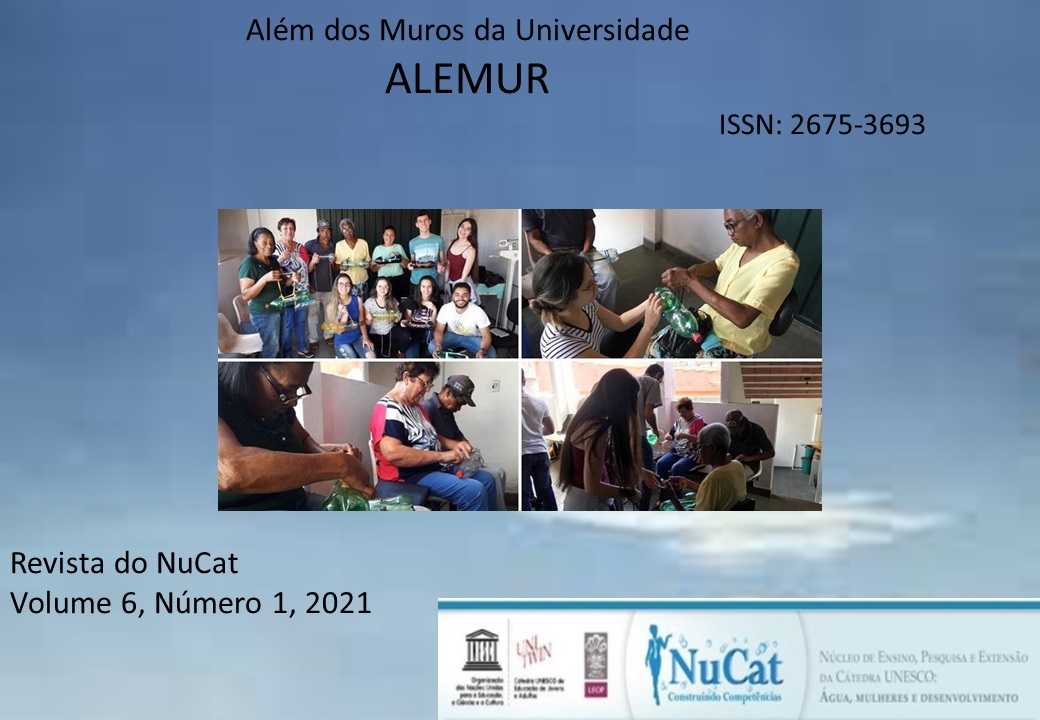Ambiental diagnosis: An analysis of the water quality of the córrego do Falcão hydrographic basin, chapada Community – Ouro Preto, MG
Abstract
The study in question deals with water quality in a sub-district of Ouro Preto, Minas
Gerais, with the main objective of identifying interference in rivers, waterfalls and sources.
Analyzes of free residual chlorine were also carried out in supply waters, responding to requests
from the community that were suspicious that the concentration was caused by permitted standards.
From the cartographic databases of the region and contact with local residents, five sampling points
were established in surface water and four in distributed drinking water. Samples used for on-site
and laboratory tests. The results obtained were satisfactory when compared to the legislation in
force in the state of Minas Gerais. The values of Water Quality Index (IQA) of surface water
samples varied from good to excellent, which means what are the characteristics of the conventional
treatment used in public supply. None of them, however, can be used for human consumption
without previous treatment, due to the presence of Escherichia coli. All measures evaluated in
relation to the concentration of free residual chlorine show values below the maximum reference
allowed.
References
ASSOCIATION, WATER ENVIRONMENT FEDERATION. Standard Methods for the
Examination of Water and Wastewater. 22. ed., WASHINGTON, D.C.: APHA, AWWA, WEF,
2012.
BILICH, M. R.; LACERDA, M. P. C. Avaliação da qualidade da água do Distrito Federal por meio
de geoprocessamento. In: SIMPÓSIO BRASILEIRO DE SENSORIAMENTO REMOTO, 12.,
2005, Goiânia. Anais... p. 2059-2.065
BONNET, B. R. P.; FERREIRA, L. G.; LOBO, F. C. Relações entre qualidade da água e uso do
solo em Goiás: Uma análise à escala da bacia hidrográfica. Revista Árvore, v. 32, p. 311-322, 2008.
Brasil. Fundação Nacional de Saúde. Manual de Cloração de Água em Pequenas Comunidades
Utilizando o Clorador Simplificado Desenvolvido pela Funasa / Fundação Nacional de Saúde. –
Brasília : Funasa, 2014. 36 p. Disponível em: http://www.funasa.gov.br/site/wp-
content/files_mf/manualdecloracaodeaguaempequenascomunidades.pdf. Acesso em: 22 mar. 2020.
BRASIL. Ministério da Saúde. PORTARIA DE CONSOLIDAÇÃO Nº 5, DE 28 DE SETEMBRO
DE 2017.
BRASIL, Resolução Conselho Nacional de Meio Ambiente - CONAMA n°357, de 17 de março de
2005. Classificação de águas, doces, salobras e salinas do Território Nacional. Publicado no D.O.U
BRASIL. Resolução CONAMA. Conselho Nacional do Meio Ambiente nº. 357 de 17 de março de
2005. Diário Oficial da República Federativa do Brasil, Brasília, DF, 2005. 23p.
DA SILVA ALVES, Luciano; MARTINS, Lorena Alencar; DE JESUS, Lucineide Bispo.
Avaliação da qualidade da água na bacia do rio Camarajipe (Salvador–Brasil): diagnóstico dos
parâmetros físico-químicos, microbiológicos e determinação do IQA. Revista Brasileira de Meio
Ambiente, v. 6, n. 1, 2019. Disponível
em:https://revistabrasileirademeioambiente.com/index.php/RVBMA/article/view/203/172. Acesso
em: 23 mar. 2020.
DOETZER, Benno Henrique Weigert et al. Diagnóstico rural participativo aplicado a Bacia do Rio
Verde, Região Metropolitana de Curitiba, PR (Brasil). In: XXXII Congreso Interamericano de
Ingeniería Sanitária y Ambiental. 2010. p. 1-8.
GERAIS, Minas. Deliberação Normativa Conjunta Copam/CERH-MG. n. 1, de 5 de maio de
2008. Belo Horionte: Diário do Executivo, 2008.
GOMES, Letícia Maria Rodrigues et al. Problemas Ambientais Causados pelo Ecoturismo no Setor
Urbanizado do Subdistrito de Lavras Novas, Ouro Preto, MG. Turismo-visão e ação, v. 5, n. 3, p.
239, 2003. Disponível
em:https://search.proquest.com/openview/3d1e6a2d4d868f308c5e1f3ebfbc4dae/1?pq-
origsite=gscholar&cbl=2032135. Acesso em: 23 mar. 2020.
INSTITUTO MINEIRO DE GESTÃO DAS ÁGUAS (IGAM). Monitoramento das águas
superficiais (2014) Disponível em:<http://portalinfohidro.igam.mg.gov.br/gestao-
dasaguas/monitoramento/agua-superficial>. Acesso em: 22 mar. 2020.
MATOS, A. T. de. Qualidade do meio físico ambiental. Viçosa: AEAGRI. (Série Caderno Didático
33) 2011, 183p
MORAES, L.R.S; ÁLVARES, M.L.P; SANTOS, F.P; COSTA, N.C.A. Saneamento e qualidade
das águas dos rios em Salvador, 2007-2009. Revista Interdisciplinar de Gestão Social 1, 47-60,
2012. Disponível em: https://portalseer.ufba.br/index.php/rigs/article/view/12067. Acesso em: 23
mar. 2020.
MUNIZ, Gustavo Lopes. QUALIDADE DA ÁGUA DO RIBEIRÃO SÃO BARTOLOMEU
AVALIADA PELO ÍNDICE DE QUALIDADE DA ÁGUA EM PONTO DE CAPTAÇÃO PARA
ABASTECIMENTO NO PERÍODO SECO. HOLOS, v. 7, p. 1-19, 2019.
UNITED STATES. Environmental Protection Agency - USEPA. Secondary maximum contaminant
levels: a strategy for drinking water quality and consumer acceptability. 2015. Disponível em:
<http://www.waterrf.org/PublicReportLibrary/4537.pdf>. Acesso em: 24 jun. 2020.
VON SPERLING, M. Introdução à Qualidade das Águas e ao Tratamento de Esgotos (Princípios do
Tratamento Biológico de Águas Residuárias; vol. 1). Belo Horizonte: DESA-UFMG, 452p. 2014.
Os autores mantém os direitos autorais dos documentos publicados na Alemur e cedem à revista o direito de publicação dos texto e seus metadados (em múltiplos suportes e formatos), inclusão em bases de dados e assinatura de acordos de indexação atuais e futuros (mesmo com licenças menos restritivas, para os textos, ou sem restrições, para os metadados), de modo a garantir a indexação do documento publicado e seus metadados.
Todos os documentos publicados são distribuídos em acesso aberto, nos termos da Licença Creative Commons Atribuição - Não-Comercial 4.0 Internacional (CC-BY-NC) que permite o uso, a distribuição e reprodução em qualquer meio desde que sem fins comerciais e que o artigo, os autores e o periódico sejam devidamente citados; garantindo uma ampla disponibilização do conhecimento científico e democratização do acesso.
A Alemur não só autoriza como incentiva que os autores e as equipes técnicas de repositórios digitais e outras bases de dados não comerciais depositem cópias dos artigos publicados em blogs pessoais, sites profissionais e locais semelhantes (sempre oferecendo a referência detalhada do documento), nos termos da Licença Creative Commons Atribuição - Não-Comercial 4.0 Internacional (CC-BY-NC).


